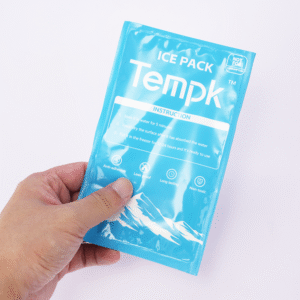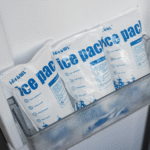Pacotes de gelo seco estão revolucionando a maneira como os bens sensíveis à temperatura são transportados. Essas soluções de refrigeração, feito de dióxido de carbono sólido, Forneça um método superior de preservar itens perecíveis, garantir que eles permaneçam congelados durante longas viagens ou remessas. Este artigo explora como os pacotes de gelo seco funcionam, seus benefícios, e como eles são usados em várias indústrias. Também vamos mergulhar nas últimas tendências para 2025, focando em como o gelo seco está se tornando uma parte indispensável da logística da cadeia fria.
-
A ciência por trás de como as pacotes de gelo seco funcionam.
-
Os vários benefícios que as bolsas de gelo seco oferecem em comparação com o gelo regular.
-
Como o gelo seco é usado na logística da cadeia fria.
-
As precauções de segurança necessárias para lidar com gelo seco.
O que é um pacote de gelo seco?
Um pacote de gelo seco é uma solução de refrigeração especial que usa dióxido de carbono sólido para manter temperaturas ultra-baixas. Ao contrário do gelo tradicional, que é à base de água e derrete em líquido, gelo seco sublima diretamente de sólido ao gás. This unique property allows dry ice to remain cold longer without the mess of melting ice.
Dry ice packs are commonly used for shipping items that need to stay frozen, como comida, medicação, e amostras biológicas, making them essential in industries like food shipping, produtos farmacêuticos, and biomedicine.
How Do Dry Ice Packs Work?
Dry ice packs function by utilizing the sublimation process of solid carbon dioxide. When exposed to warmer temperatures, the dry ice changes from solid to gas, absorbing heat in the process. This results in extremely low temperatures, with dry ice reaching as low as -109.3°F (-78.5°C), making it ideal for keeping items frozen for extended periods.
Exemplo: If you’re shipping frozen seafood from one city to another, a dry ice pack can maintain the necessary low temperatures for up to 48 horas, ensuring the seafood remains fresh without the worry of ice melting and damaging the goods.
Principais benefícios dos pacotes de gelo seco
-
Duração de resfriamento mais longa
Dry ice packs can maintain cooling for much longer than traditional ice. Depending on the size and insulation of the pack, dry ice can stay frozen for up to three days, ensuring that your goods stay cold during extended shipments.
-
Sem água derretida
Ao contrário do gelo regular, which melts into water and creates a mess, gelo seco sublima diretamente no gás. This means there is no water residue, making it easier to handle and transport, especially for industries where water damage could ruin sensitive products.
-
Super Cold Temperatures
With the ability to reach temperatures as low as -109.3°F (-78.5°C), dry ice is perfect for products that need to remain frozen during transport, como vacinas, certain foods, e farmacêuticos.
-
Versatility and Portability
Dry ice packs come in different forms, such as pellets, blocos, and sheets, each catering to specific needs. Whether you are shipping biological samples or keeping food fresh during a road trip, dry ice packs are versatile and easy to transport.
| Recurso | Pacote de gelo seco | Gelo regular | Advantage for Users |
|---|---|---|---|
| Duração do resfriamento | Até 3 dias | 4-6 horas | Longer cooling time |
| Faixa de temperatura | -78.5°C (-109.3°F) | 0°C (32°F) | Much colder temperature |
| Water Production | Nenhum | Sim | No melting or sogginess |
| Packing Flexibility | Flexível, compactar | Bulky, leaks water | Easy to pack, no leaks |
How to Safely Handle Dry Ice Packs
Handling dry ice requires extra caution due to its extremely low temperatures. Always follow safety guidelines to avoid frostbite or damage to your equipment:
-
Wear Gloves: Insulated gloves are essential when handling dry ice to prevent burns or frostbite.
-
Ventilação adequada: O gelo seco sublima em gás dióxido de carbono, which can displace oxygen in closed spaces. Always use dry ice in well-ventilated areas to prevent asphyxiation.
-
Never Seal in Airtight Containers: Dry ice needs room to sublimate into gas. Sealing it in an airtight container can cause the container to explode due to pressure buildup.
The Uses of Dry Ice Packs
Dry ice packs are used in various industries, offering solutions for different transportation and storage needs:
-
Logística da Cadeia Fria
Na indústria da cadeia fria, dry ice is a critical component for keeping temperature-sensitive goods, como vacinas, insulina, e alimentos congelados, at the required temperatures. Dry ice is essential for ensuring these products remain viable during long transport durations, especially when air travel is involved.
-
Medical and Pharmaceutical Shipping
Dry ice is widely used in the transportation of biologics, vacinas, and other medical supplies that need to be maintained at ultra-low temperatures. The ability to keep these items at consistent low temperatures is crucial for maintaining their efficacy.
-
Food and Beverage Industry
Shipping frozen foods, frutos do mar, or dairy products often requires a reliable cooling solution. Dry ice packs are ideal for ensuring these items arrive at their destination in perfect condition, even over long distances.
What Are the Latest Trends for Dry Ice Packs in 2025?
À medida que nos mudamos para 2025, the use of dry ice packs in various industries is expected to grow. The cold chain logistics industry is increasingly relying on dry ice due to its efficiency and effectiveness in keeping products frozen. Adicionalmente, advancements in packaging technology are making dry ice use safer and more cost-effective.
Desenvolvimentos recentes:
-
Smarter Packaging Technology: New packaging options are making dry ice cooler and more efficient, extending the duration it remains effective.
-
Increased Demand in the Pharmaceutical Sector: The growth of temperature-sensitive vaccines and biologics has driven the demand for dry ice, making it a staple in the medical shipping industry.
Insights de mercado
The demand for dry ice continues to rise, driven by the increasing need for efficient shipping solutions in the pharmaceutical and food industries. As logistics companies work to reduce emissions and improve sustainability, the use of closed-loop CO₂ systems to capture and reuse sublimated carbon dioxide is expected to gain traction.
Perguntas frequentes
Q1: How long does dry ice last?
Dry ice typically lasts between 18 para 48 hours depending on the size and the insulation of the shipping container. Larger blocks last longer than smaller pellets.
Q2: Can dry ice packs be reused?
Sim, dry ice packs can be reused multiple times. Após cada uso, simply store the packs in a well-ventilated area to allow them to sublimate and cool down.
Q3: How do I dispose of dry ice?
Allow unused dry ice to sublimate in a well-ventilated area. Do not dispose of it in a sealed container or down plumbing, as it can cause damage.
Conclusão e recomendações
Dry ice packs provide an efficient and effective way to keep temperature-sensitive goods cold during transit. Their superior cooling power, long-lasting performance, and versatility make them an essential tool for industries that require precise temperature control. To take full advantage of dry ice, be sure to follow all safety precautions and stay informed on the latest trends for 2025.
PRÓXIMOS PASSOS: Ready to enhance your cold chain shipping process? Contact us for expert advice on choosing the right dry ice pack for your needs.
Sobre Tempk
Tempk is a leader in providing advanced cold chain solutions, specializing in high-quality dry ice packs. We help businesses optimize their shipping processes, ensuring that goods remain safe and cold throughout transportation. Our products meet all industry regulations and are designed for efficiency and reliability.
For more information, visit our website or reach out to our expert team today.
























